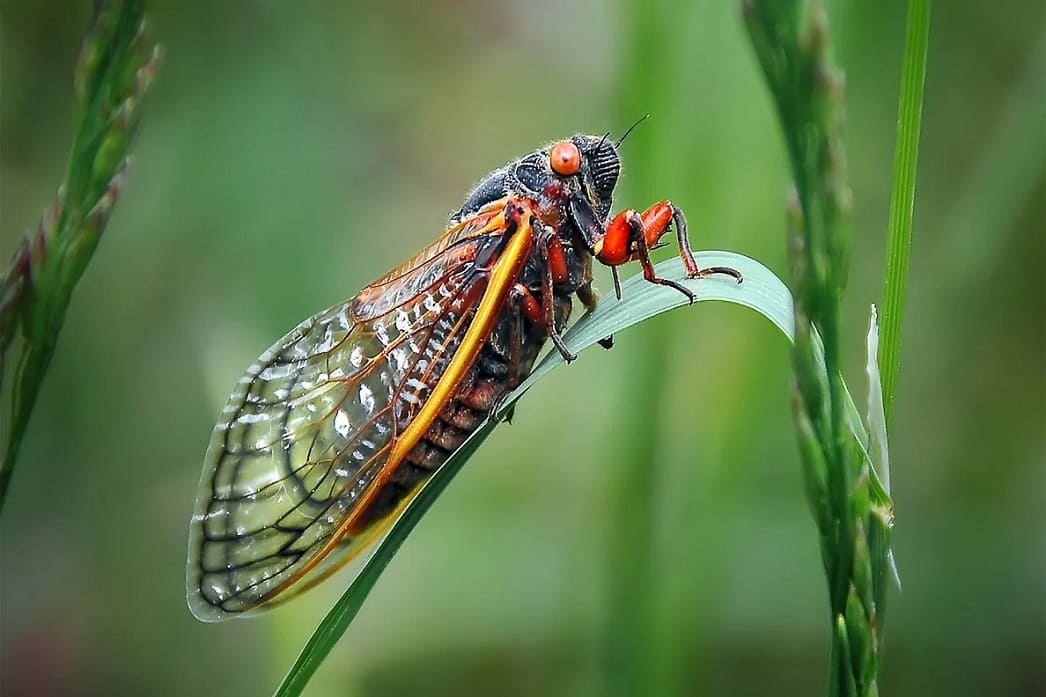Picture this: You’re enjoying your morning coffee on the patio when suddenly, the air fills with a sound somewhere between a motorcycle revving and a distant chainsaw.
You look up to see your oak tree covered in large, red-eyed insects that seem to have appeared overnight. Welcome to cicada season—one of nature’s most spectacular and misunderstood phenomena.
If you’re a gardener facing a cicada emergence, you’re probably wondering whether these prehistoric-looking creatures will turn your carefully tended landscape into a wasteland. The short answer? Your tomatoes are safe, but your young maple might need a little protection.
By the end of this guide, you’ll understand exactly how to navigate cicada season like a seasoned pro, protecting what needs protection while appreciating the remarkable natural event unfolding in your backyard.
Here’s How to Get Rid of Grasshoppers: Effective Control And Prevention Tips
Understanding Your Temporary Garden Guests
The Two Types of Cicadas You’ll Encounter
Not all cicadas are created equal, and understanding the difference can save you unnecessary worry.
1. Annual cicadas are the familiar summer soundtrack—those green, dog-day cicadas that appear reliably each July through September. They live 2-5 years underground but emerge in overlapping cycles, so you see some every year.
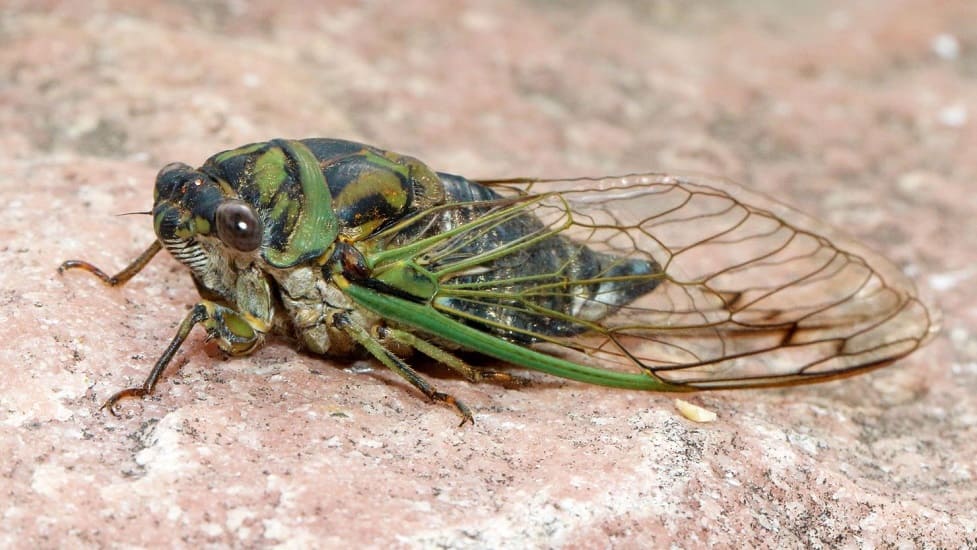
2. Periodical cicadas are the real showstoppers. These smaller, black-bodied insects with striking red eyes follow precise 13 or 17-year cycles, emerging all at once in staggering numbers.
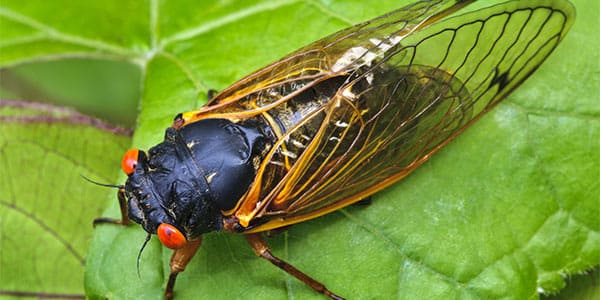
When people talk about “cicada emergencies” or “broods,” they’re referring to these synchronized spectacles that can reach densities of 1.5 million insects per acre in wooded areas.
The mathematical elegance behind their timing is fascinating—13 and 17 are both prime numbers, making it nearly impossible for predators to sync their own life cycles to cicada emergences. It’s nature’s own strategic planning at work.
The Complete Lifecycle Story
Understanding the full cicada story helps demystify what’s happening in your yard. Adult females slice small pockets into pencil-thin branches and deposit about 20 eggs in each slit, laying up to 600 eggs total. Six to ten weeks later, tiny ant-sized nymphs hatch and immediately drop to the ground, where they burrow 6-18 inches deep to find tree roots.
These nymphs will spend the next 13 or 17 years underground, slowly growing through five developmental stages while feeding on root sap. When their time comes, they tunnel upward, emerge en masse, shed their brown exoskeletons on whatever vertical surface they can find, and the cycle begins anew.
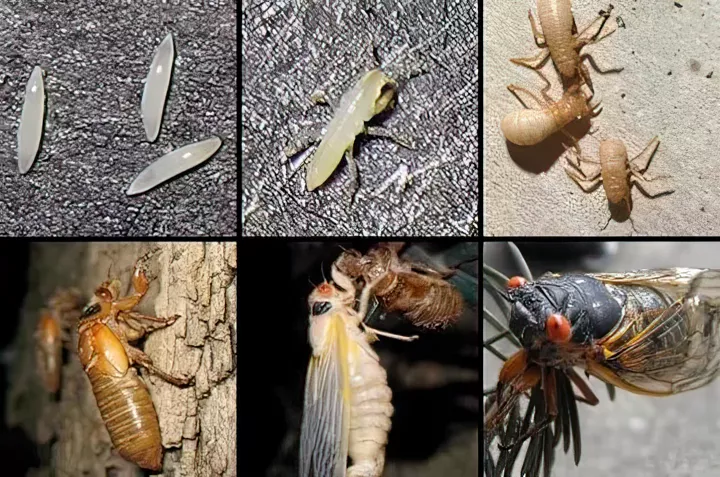
Decoding the Emergence Timeline
Cicadas are remarkably predictable once you understand their triggers. They emerge when soil temperatures reach 64°F at a depth of 8 inches—typically late April in southern regions, stretching into June in cooler areas. The entire above-ground spectacle lasts about 4-6 weeks.
Last spring, my neighbor Sarah noticed small mud chimneys appearing in her lawn—penny-sized holes with tiny towers of earth around them. Two weeks later, her yard was buzzing with thousands of newly emerged cicadas. Those chimneys are actually advance notice that emergence is imminent.
Separating Cicada Fact from Fiction
What Cicadas DON’T Do
Before we dive into protection strategies, let’s clear up the biggest misconceptions. Cicadas will not:
- Eat your vegetable garden (they can’t chew)
- Bite or sting you (they lack the equipment)
- Poison your pets (they’re actually nutritious, though too many can cause stomach upset)
- Destroy your lawn (the holes actually provide beneficial aeration)
- Strip your mature trees bare (they prefer sap over leaves)
👉 Related post: Crane Flies Explained – Not the Pests You Think They Are
The Real Impact: Noise and Egg-Laying
The two genuine concerns during cicada emergences are noise levels and branch damage from egg-laying. Male cicadas can produce sounds reaching 80-100 decibels—equivalent to a lawn mower or motorcycle. If you’re sensitive to noise or planning outdoor events, consider investing in earplugs during peak activity hours (typically 10 AM to 5 PM).
The only plant damage comes from female cicadas cutting slits in branches to deposit eggs. This “flagging” can cause small branches to turn brown and break off. On mature trees, this acts like natural pruning and often increases flowering the following year. Young trees with many pencil-thin branches face greater risk.
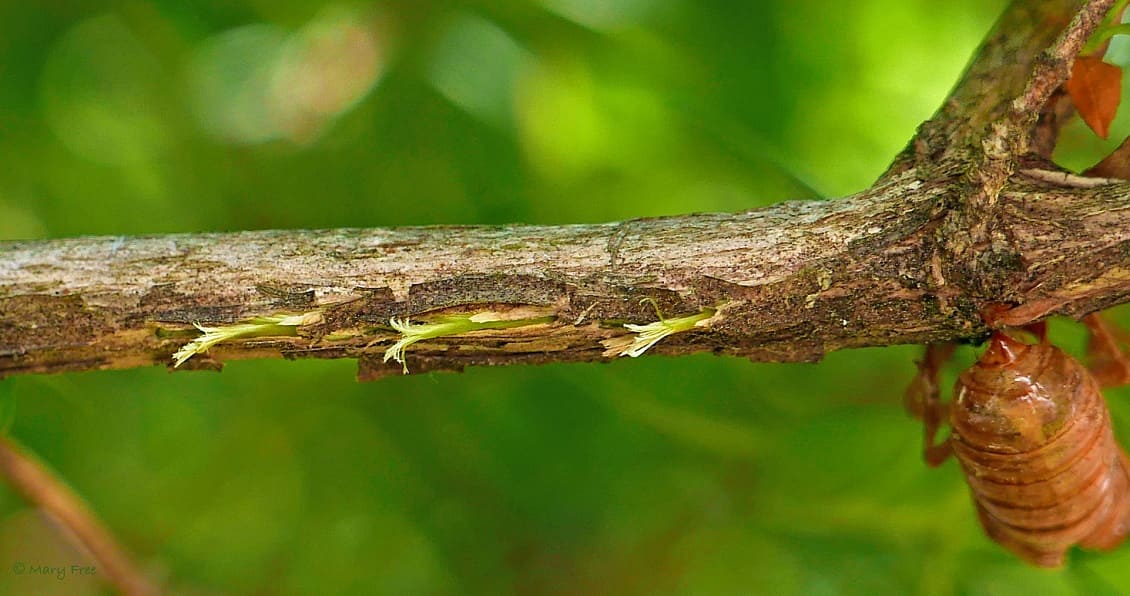
Your Garden Plant Risk Assessment
High-Risk Plants (Provide Protection)
Focus your protection efforts on:
- Newly planted trees (under 4 years old)
- Fruit trees with pencil-thick branches
- Small ornamental shrubs like dogwood, redbud, and hawthorn
- Berry bushes including blueberries and brambles
- Young hardwood trees such as oak, maple, and cherry
Low-Risk Plants (Relax and Enjoy)
These plants are essentially cicada-proof:
- All vegetables and herbs (they have no woody branches for egg-laying)
- Annual flowers and most perennials
- Evergreen trees (conifers hold no appeal for cicadas)
- Mature trees with substantial trunks and thick branches
- Grasses and groundcovers
👉 Discover Top 22 Evergreen Junipers for Ground Cover and Garden Protection
The Art of Cicada-Proofing Your Garden
Timing Your Protection Strategy
You’ll have about a week after males begin their mating calls before females start seeking egg-laying sites. Use this window to implement protective measures, and plan to maintain them for the full 4-6 week emergence period.
The Netting Method
Fine mesh netting remains the gold standard for protection. Use material with holes ¼ inch or smaller—mosquito netting, cheesecloth, or specialized insect netting all work well. Standard bird netting won’t work as the holes are too large.
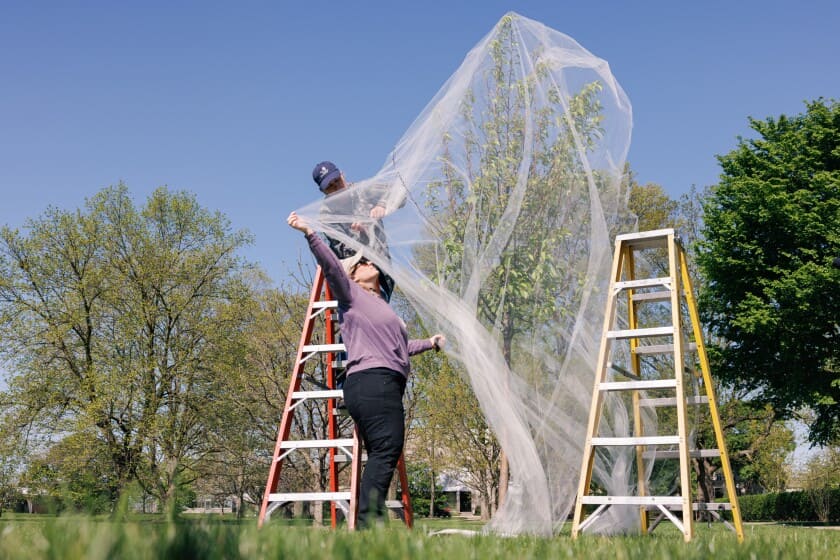
Drape netting completely over vulnerable plants and secure it tightly around the trunk base. Cicadas are persistent climbers, so any ground-level gaps become entry points. Remove netting promptly once emergence ends to prevent growth interference and shading issues.
Alternative Strategies
If you know an emergence is coming, delay planting new trees and shrubs until fall. Remove weak or damaged branches before emergence begins, as stressed wood attracts more egg-laying activity. For large trees where full netting isn’t practical, trunk barriers can prevent cicadas from climbing to the canopy.
Chemical Control Reality Check
Avoid pesticides entirely. Studies show netting prevents 8-25 times more damage than chemical applications, and pesticides harm beneficial insects plus the wildlife that feast on cicadas. With millions of cicadas in the area, chemical treatments are both ineffective and environmentally damaging.
Beyond the Garden: Practical Home Management
Maintenance Tasks During Emergence
Cicadas create surprisingly practical challenges beyond plant protection. Check and clean gutters frequently, as dead cicadas can cause clogs during a period when you might not expect them. Pool owners should clean skimmers and filters regularly, or better yet, cover pools entirely to prevent accumulation.
HVAC units can become clogged with cicadas, reducing airflow and straining equipment. A weekly spray-down with your garden hose keeps outdoor air conditioning components clear. If you have ornamental ponds, cover them with screening to prevent oxygen depletion from decomposing cicadas.
Pet Safety Guidelines
While cicadas aren’t toxic to pets, there are practical considerations for dog and cat owners. The crunchy exoskeletons can pose choking risks, and pets that overindulge may experience stomach upset or vomiting.
Most pets can safely eat a few cicadas without problems, but monitor their consumption and contact your veterinarian if you notice distress.
Keep outdoor cats inside during peak emergence if possible—not because cicadas are dangerous, but because the sheer volume of potential prey can lead to overeating and digestive issues.
👉 Discover 22 Pet-Friendly Ways to Stop Cats Pooping in Your Garden
The Hidden Benefits of Cicada Visits
Natural Garden Improvements
Those thousands of emergence holes provide permanent soil benefits, improving water infiltration and air circulation around root systems. When cicadas die in massive numbers after mating, their bodies decompose into nitrogen-rich fertilizer that often produces noticeably greener lawns and lusher plant growth.
👉 Here’s How to Add Nitrogen to Soil: 18 Quick Fixes + Long-Term Solutions
The flagging caused by egg-laying frequently improves tree structure and health, with many trees producing more flowers and fruit the year following cicada pruning. The emergence also creates temporary food bonanzas for birds and mammals, supporting higher reproductive success in local wildlife populations.
Planning for Future Emergences
Different regions host predictable cicada broods on known schedules. Understanding your local pattern helps you time protection strategies and plant installations.
You can find detailed brood maps and emergence predictions through university extension services or apps like Cicada Safari, which also lets you contribute to scientific research by documenting local cicada activity.
Post-Emergence Garden Care
Don’t rush to clean up dead cicadas—they make excellent natural fertilizer. Rake them into garden beds or add them to compost piles, mixing with brown materials like leaves to prevent odors. If the smell becomes overwhelming, bury them directly in soil where they’ll decompose into valuable nutrients.
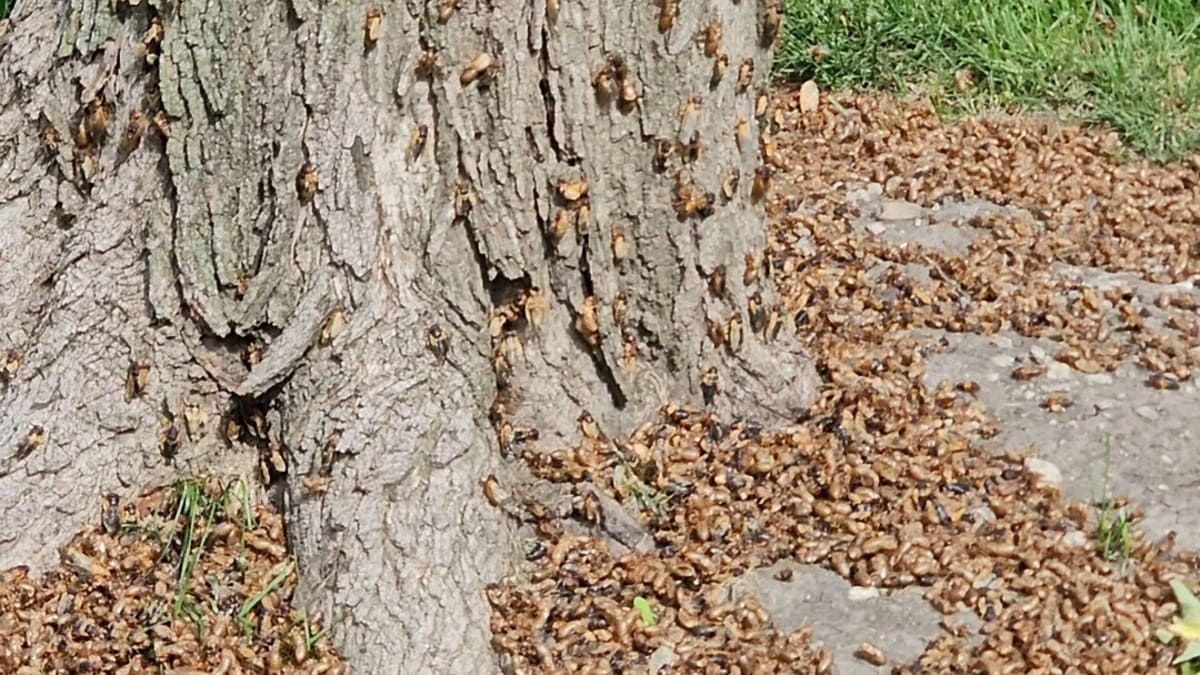
Wait at least six weeks before pruning flagged branches, as some may recover. When you do prune, make clean cuts just above healthy buds. Support damaged plants with consistent watering and organic mulch, but avoid additional fertilizing since decomposing cicadas provide abundant nutrients naturally.
Embracing the Spectacle
The Bigger Picture
Rather than viewing cicadas as pests, consider them participants in one of nature’s most remarkable synchronized events. These creatures have perfected their strategy over millions of years, creating temporary biological spectacles that occur nowhere else on Earth.
Cicada emergences offer incredible educational opportunities and tangible lessons about life cycles, mathematical patterns in nature, and ecosystem interconnections. Many cultures throughout history have viewed cicadas as symbols of renewal and transformation—fitting metaphors for creatures that wait over a decade for their brief moment in the sun.
Your Action Plan
For successful cicada season management, protect young trees and valuable shrubs with fine netting, skip chemical treatments entirely, maintain gutters and outdoor equipment, monitor pets for overindulgence, and embrace the fertilizer benefits when it’s all over.
Most importantly, remember that the vast majority of your garden needs no intervention whatsoever. Your vegetables will thrive, your mature trees will benefit from natural pruning, and your soil will receive a nitrogen boost that lasts for months.
The next time you hear that distinctive cicada chorus building in your neighborhood, you’ll know exactly which plants truly need protection and which will benefit from the natural processes these remarkable insects bring. You’ll be prepared to appreciate one of nature’s most spectacular temporary takeovers while keeping your garden healthy and thriving.
Have you experienced a major cicada emergence before? What strategies worked best in your garden? Share your cicada stories and questions in the comments below.
